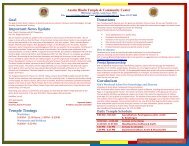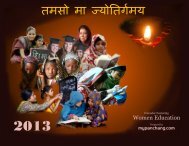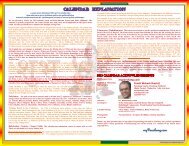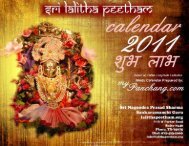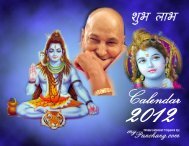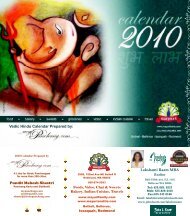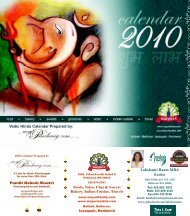Differences in Festival dates between India and USAThe Indian Calendar/Panchangam is used everywhere whereHindu people live. I even see people posting, “ I want pambuPanchangam, but I live in the USA and it is not available”. Thequestion then arises: “Can Indian Panchangam be usedoutside of India?”.People usually align the Hindu festivals with the English datesbased on the Indian calendar. They then think that if an Indiancalendar says “Janmasthami” on a certain date, saySeptember 2 nd 2010, then it will appear as September 2 ndeverywhere in the world. The USA is 10:30 to 15:30 hoursbehind India, so some people will think it will also <strong>com</strong>e thenext day in the USA, i.e. September 3 rd 2010. They also arguethat their family priest in India has told them to celebrate onthis particular date and according to him the Indian calendarwill apply to all places in the world. This is a <strong>com</strong>pletely wrongassumption.The English date and day (Sunday, Monday, Tuesday etc..)changes at midnight; whereas the Hindu date (or Tithi) andday does not change at midnight. Hindu days change atSunrise. All days are from one Sunrise to another Sunrise.Sunday will start at one Sunrise and end at the next Sunrise.The Hindu date (or Tithi -- depending on the position of theSun and Moon at any given time) changes as celestial bodiesmove. It can change anytime between two Sunrises. That is tosay that if Prathama Tithi ends today at 23:02 it does notmean that Dwitiya Tithi will end tomorrow at the same time.It can end at 18:00, 18:09 or 28:27 (anytime after 24 meansafter midnight but before the next Sunrise).Now what's the Hindu date (Tithi)?It is simple. A Tithi is a lunar day, or the time it takes for thelongitudinal angle between the Sun and the Moon to increaseby 12°. Tithis begin at varying times of day and vary induration from approximately 19 to 26 hours. So the maximumdistance between the Sun and the Moon can be 360 degrees.If you divide them by 12 degrees that gives you 30 equalparts. This means that we have 30 dates in the Hindu calendardivided between the bright half (Shukla Paksha, WaxingMoon), and the dark half (Krishna Paksha, Waning Moon).Panchangam contains two types of calculations. One is basedon the local coordinates like longitude and latitude (Sunrise,Sunset, Moonrise, Moonset, etc), and the other is based ongeocentric planetary positions.Sunrise, Sunset, Moonrise, Moonset times are alwayscalculated for each and every place on the Earth. LocalSunrise, Sunsets are used to find the daily Rahukalam,Yamagandam, Gulikai, and Durmuhurtham times.The other set of calculations are calculated from the center ofthe Earth (geocentric). The positions of heavenly bodies arecalculated from the center of the Earth and hence they aregeocentric. The planetary positions are first calculated fromthe center of the Sun (heliocentric) and then using thespherical trigonometry they are converted to the center of theEarth (geocentric). The Tithi, Nakshatra, Yoga, Karana anddaily planetary positions are based on the positions of the Sunand Moon in the heavens and they are part of theastronomical phenomenon. These are astronomicalphenomenon which happen instantly at the same moment onEarth, and hence the Tithi and Nakshatra will end at the sametime all over the world. We have to, therefore, convert themto the local standard time of the specific country of interest.When an eclipse occurs and is visible all over the world, thetime of occurrence is converted into each country’s local timezone. The planets do not wait for Sunrise or Sunset at theparticular place. They just keep moving, like Earth is movingaround the Sun.These planetary positions of the Sun and the Moon are<strong>com</strong>puted based on the local time (longitude, latitude)converted to the Universal Time. The Tithi end time is alsocalculated in the Universal Time which is then converted tothe local time of the place. The planets are calculated fromthe center of the Earth and their positions at the given timewill be the same all over the world. In the same way,whenever any celestial event occurs we need to convert it toour local time zone. Indian Panchang makers convert this toIndian time. The same say we need to convert it to our timezone for America (PST/PDT, CST/CDT, MST/MDT, EST/EDT).After adding the time difference we get the resulting Englishdate and time when they end. Hence, when the calendar ismade for India the date they mention is when that Tithi willend as per the English date in India. If we take the same dateand time use it anywhere in the world as it is then we willhave wrong results.For example:On October 17th 2008 the Ashwayuja (Ashwin) KrishnaPaksha/ Poornimant Kartik Krishna Paksha Tithi Tritiya ends at16:39:21 Indian Standard Time, and Charturthi starts. Thatmeans at 16:00 hours there is Tritiya still prevailing in India.Now on October 17th 2008 in Seattle, WA at the 16:00 hourswe won't have Tritiya at that time. We already have Chaturthistarted. Planets keep on moving.... 13 hours have passed andthe position of Sun and Moon have changed. So what time willTritiya end in Seattle? The time difference is 13 hours 30minutes (with one of our Daylight Saving Time it gives thedifference of 12 hours 30 minutes from IST). So, let's subtractPundit Mahesh ShastrijiPanchang Ganitha and Siddhanta<strong>myPanchang</strong>.<strong>com</strong>, seattlepandit.<strong>com</strong>12 hours 30 minutes from the 16:39:21. That gives us04:09:21 AM on October 17th. So on October 17th after thattime we'll have Chaturthi Tithi and before we have Tritiya. Thesame way if Tithi ends at 8:39 AM on Septemer 12 in India itwill end at 20:09 PM on September <strong>11</strong>th in Seattle. The sameway Western Australia is 8 hours ahead of GMT and hence theChaturthi will end there at 12:09 PM on September 12th. Theplanets do not wait for the appropriate Tithi to arrive on someEnglish date at any location in the world. If it did we wouldnot have any days and nights (if it were to happen thencelestial bodies would remain static in sky). The Earth is roundand it keeps moving, so we have days and nights. It does notwait for Tithi or festivals. Time never waits for anyone. It goeson. The Sun does not rise instantly at the same time all overthe world. Hence we need to convert the Tithi, Nakshatra,Yoga, and Karana time to local standard time. Now we knowwhat time a given Tithi ends, so now it is time to decidefestival dates for each region.How festivals are determined?The usual rule to observe a festival for a particular day, checkwhich Tithi prevails at that Sunrise. Each festival has differentrules of observance. For example: Ganesh Chaturthi.Sankathara (Sankshathi Chauth) Chaturthi, Janmashtami,Mahashivaratri, Karwa Chauth, etc... For example GaneshaChaturthi has to be oserved when the Chaturthi Tithi isobserved during the 8th/15th part of the dinmana or the3/5th part of the dinmana. The dinmana is the differencebetween local Sunset and Sunrise on the same day. IfChaturthi is not prevailing during that period then take thesecond day. Likewise for the Karwa Chauth and theSankathara Chaturthi the Chaturthi Tithi must be prevailingduring the moonrise time, if it does not prevail then take theday where it prevails during the sunrise. Rules to determineShraddha Tithi are different.For example, if one Tithi is observed at moonrise in India itmay or may not exist during moonrise on the same day in adifferent part of the world. It may be very well observed onthe previous day if you are in America or the next day if youare in Japan, Fiji, Australia and other countries. America isbehind India in terms of time. To arrive at the time in India weneed to subtract the time from Indian time and hencefestivals could arrive a day early in USA but not later. Forexample if a total lunar eclipse is visible in India at 5:00 AM itwill happen on the previous day in the USA.For these reasons Indian Panchangam you buy in India cannotbe used outside of India.
ARIES / Mesha (March 21 to April 20): Beginning of the year guru will give you some grief with respect to your health,and increased expenditure. Your financial gains will continue in the first three months. You'll continue to work hard andyour health will suffer as a result. Next three months April, May and June your expenses will rise, troubles will increase butworking hard will ease these problems with the help of Shani dev after mid May and will continue till june. You might haveto pay some money to government agencies in the first half of the year. July will also continue to give you more benefits.Increase in <strong>com</strong>petition after sept 10 can be felt but this will be temporary. The power of good result of Saturn can be feltin the later part of this year as Shanidev will be changing rashi in the mid November. Overall this year will be good for yourfinancial gains. Change in job may be indicated in the later part of the year due to Shani transist. Health of maternal uncleneeds to be watched.TAURUS/Vrishabha (April 21 to May 20): Beginning half of the year guru dev is transiting over your benefic housesindicating financial gain till May, after that you need be careful about your health. ShaniShanidev throughout the year willbe transiting over your 5th house causing worries related to your children. If you are into heavy stock market and gamblingthen here is the red flag for you. Be watchful. In the midst of some gain in the first part of the year the second part willbring more expenses. However you are facing some hard challenges on expenses front from the beginning of the year butsome financial gains with intervention from guru kept your boat going. Rahu will be transiting over you 7th house in thesecond half which will cause you problems with your spouse and family relations. If you have any government noticesplease do not ignore.GEMINI / Mithuna (May 21 to June 20): You need to be watchful of your work in the first half of the year. Gurudevtransiting over your 10th house could bring some changes at work which may not be pleasing to you, but Rahu's transit willensure you still have a job. Don't lose your confidence, and temper. Keep working hard and your hard work could gain yousome gains with respect to new challenges, promotion, etc in the 2nd half. Your Saturn throughout the year is in the 4thhouse hence mother's health needs to be very careful. Those who are students are advised to make sure to work hard andcheck exam schedules and dates and times, else you could lose one year. Saturn will create some unrest for you but if youwork hard it shouldn't give you much trouble. There might be some additional worries related to your home and propertyexpenses. The second half of the year your expenses will increase. This year isn't good for your stock market, or gambling.Be watchful.CANCER / Karka (June 21 to July 22): Guru transiting over your 9th house could gain you some additional money, evenhelp of superior, bosses. Work hard to make impressions on your superiors. Shani transiting over your benefic housethroughout the year ensures continuous gain till the end of year. Even Rahu's transit over benefic house brings more goodnews for you. However in the second half of the year gains you always had could slow down. Guru moving to your 10thhouse demand more attention from your work in the later part of the year however Saturn will ease things but you need towork hard. Rahu who was giving you good gains in the first half also changes sign in july brining some expenses. Themonth of December will be interesting as Saturn who was protecting you so far is changing sign in mid November and withthat protection gone the year end could bring more troubles at work.LEO / Simha (July 23 to August 22): The Last part of saturn's sadesati is already causing some expenses, troubles at work,slow work. To add to trouble Guru will continue to give you some troubles, expenses till May. hence till may its doublejeopardy of troubles for you. Rahu has already joined this equation till July hence triple jeopardy of troubles in the first halfof the year. The second half will bring some relief with guru changing its sign to aries causing some financial gains. Helpthat you never had from your boss or mentor will be easy now. However, Shani's last part will make you work hard.Although you may experience some gains but life is not yet that easy. Your health will cause some troubles in the secondpart. The things will ease financially after Shanideca changes rashi to tula in mid November. After that Shani will be veryeasy on you. Worship of Shanidevata, hanuman chalisa is advised.VIRGO/Kanya (August 23 to September 22): Guru's transiting over your 7th house in the beginning of the year till thefirst half give you gain of respect. Those who are single could get married before May. Shani devta who is transitingover your lagna gives you ill health and the second part of the year will show more of that. Rahu will be transiting overyour 3rd house in the second part of the year indicates sudden gains. Guru's transit over your 8th house gives you someunplanned expenditures but RRahu's blessings will get resources and some in<strong>com</strong>e. Overall this year will be mixed foryou. you are into the second part of the sadesati. Work hard but be watchful of your health. Avoid eating cold food,without heating it up.20<strong>11</strong> HoroscopeLIBRA / Tula (September 23 to October 22): Be careful of eating disorders, avoid sugar, fatty foods for the first half of theyear. Stomach troubles are indicated till May along with increased <strong>com</strong>petition, and some troubles from hidden enemies.Just keep calm. Don't lose your patience. Shani's transit over you 12th house means first part of sade sati continues thisyear till mid November. be careful in what you tell others. Avoid visits to extreme cold places. Guru changing rashi to ariesin may means good news for you. The hard work you've done in the past year and the first part of the year will give yousome rewards. If you are single you can start looking suitable match now. There is very good chance you could getmarried. The differences with your family members can increase in the second part as Rahu changes sign in july. Overall becareful of your health, watch your sugar levels. Work out regularly. The second half of the year brings some relief not fullrelief.SCORPIO/Vrischika (October 23 to November 22): Guru maharaj is very happy on you this first part of the year. He isshowering his blessings to you in terms of increase of a family member in the first part of the year. A birth in the familypossible. Shani devata in your <strong>11</strong>th house continues the gain given to you by guru graha in the second part of the year. Butas you know things don’t <strong>com</strong>e cheap. Rahu's transit over your first house could introduce some new troubles andchallenges for you. Just be careful in the second part of the year. Worship of durgamata is advised. To add more pain guruis changing rashi in May and hence <strong>com</strong>bine guru and RahuRahu could bring some health issues and trouble with enemies.Shanidevata changing rashi in mid november. Last part of November and December whole month you need to be verycareful at the same time you'll enter into Shani maharaj's sadesati period.SAGITTARIUS / Dhanus (November 23 to December 22): Your rashi lord throughout the year will be very good for you.Proper investment in stock market or other kind of planning is advised after May. First part is also very good. You can buy6.37 carets yellow sapphire to get more gains from guru provided guru in your birth chart isn't connected to malefichouses. Birth in the family possible after May. However with all this gains, you will not be satisfied at work front. Shani'stransit over 10th house through out the year introduces new challenges, slow decisions could impact your performance.Please be watchful with your relations with your manager. The second part could bring more troubles with respect tohealth. Rahu's transit over 12th house isn’t very good sign for those who have chronic illness or remain sick all the time.You'll have mental tension. Do you know that popular saying, "When things are bad don't make it worst". Keep your clam.Worship goddess durga and your rashi lord guru maharaj to avoid ill effects of Rahu in the second part of the year.CAPRICORN / Makara (December 22 to January 19): Those who didn't make any change of residence of places or city it’spossible to have before may. After that guru maharaj transiting over your 4th house gives you good financial gains. Possiblyyou can buy a new home. Shanideva transiting over your 9th house gives you kind of mental unrest and worries. This willincrease in the second half of the year. I will advise you to chant hanuman chalisa daily 3 times a day for mental peace andprosperity. Even you are not having good luck with relations with your manger. Your father's health could add moreworries in this year. Rahu transiting over your 12th house till July adds to this mental unrest and worries. Things will getbetter after July with respect to Rahu will give you material gains but you still need to work on your personal skills.AQUARIUS / Kumbha (January 20 to February 18): Guru will continue to give gains till May. More financial gains expectedtill May. But at the same time your health continues to give you worries which will increase in the second part of the year.Rahu who is very good in the first part adding to your financial gains offered by guru is changing sign in July increasingmore disputes, differences of opinions with people at work in the second part of the year. Guru changing sign in May overyour 3rd house could bring change of place, work, or location. Overall the second part of the year is very tough. You needto work hard on your skills, develop some patience. Worship of durgadevi and lord anjaneya is advised.PISCES / Mina (February 19 to March 20): Guru transiting over lagna gives you some hidden fear. Meditation, yoga is yourbest bet for the first part of the year. Shani transiting over your 7th house could give you some travels this year. If you arepostponing your travel plans for long time why wait? The second half of the year is the best time to visit places you alwayswanted to visit. Shanidevata will make things easy for you. What's more the necessary finances can be arranged by gurudevata after the mid May. But you will be always worried about your work and other things in the second half of the year.The first part the year you need to work around with differences with people you love and work with. Overall this year ismixed. Worship of RRahu is advised.For best result please use your moonsign, lagna and the sunrise and <strong>com</strong>bine with your birth horoscope. For more help visit http://mypanchang.<strong>com</strong>/astrology




